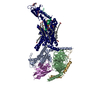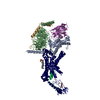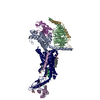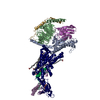[English] 日本語
 Yorodumi
Yorodumi- EMDB-26179: Human Amylin2 Receptor in complex with Gs and human calcitonin peptide -
+ Open data
Open data
- Basic information
Basic information
| Entry |  | ||||||||||||||||||||||||
|---|---|---|---|---|---|---|---|---|---|---|---|---|---|---|---|---|---|---|---|---|---|---|---|---|---|
| Title | Human Amylin2 Receptor in complex with Gs and human calcitonin peptide | ||||||||||||||||||||||||
 Map data Map data | post-processed consensus map | ||||||||||||||||||||||||
 Sample Sample |
| ||||||||||||||||||||||||
| Function / homology |  Function and homology information Function and homology informationartery vasodilation involved in baroreceptor response to increased systemic arterial blood pressure / calcitonin receptor binding / basement membrane assembly / calcitonin binding / amylin receptor complex 1 / amylin receptor complex 2 / adrenomedullin binding / cross-receptor inhibition within G protein-coupled receptor heterodimer / amylin receptor complex 3 / adrenomedullin receptor activity ...artery vasodilation involved in baroreceptor response to increased systemic arterial blood pressure / calcitonin receptor binding / basement membrane assembly / calcitonin binding / amylin receptor complex 1 / amylin receptor complex 2 / adrenomedullin binding / cross-receptor inhibition within G protein-coupled receptor heterodimer / amylin receptor complex 3 / adrenomedullin receptor activity / adrenomedullin receptor complex / vascular associated smooth muscle cell development / adrenomedullin receptor signaling pathway / amylin receptor activity / calcitonin receptor activity / calcitonin gene-related peptide receptor activity / amylin receptor signaling pathway / positive regulation of adenylate cyclase activity / Calcitonin-like ligand receptors / positive regulation of vasculogenesis / bicellular tight junction assembly / regulation of G protein-coupled receptor signaling pathway / adherens junction assembly / negative regulation of vascular permeability / feeding behavior / negative regulation of ossification / sprouting angiogenesis / negative regulation of bone resorption / negative regulation of smooth muscle contraction / activation of protein kinase activity / response to pain / positive regulation of protein kinase A signaling / monocyte chemotaxis / neuronal dense core vesicle / response to amyloid-beta / detection of temperature stimulus involved in sensory perception of pain / PKA activation in glucagon signalling / hair follicle placode formation / developmental growth / smooth muscle contraction / neuropeptide signaling pathway / D1 dopamine receptor binding / cellular response to vascular endothelial growth factor stimulus / intracellular transport / vasculogenesis / renal water homeostasis / Hedgehog 'off' state / negative regulation of endothelial cell apoptotic process / coreceptor activity / adenylate cyclase-activating adrenergic receptor signaling pathway / activation of adenylate cyclase activity / response to glucocorticoid / clathrin-coated pit / cellular response to hormone stimulus / regulation of cytosolic calcium ion concentration / cellular response to glucagon stimulus / regulation of mRNA stability / adenylate cyclase activator activity / embryo implantation / regulation of insulin secretion / positive regulation of calcium-mediated signaling / hippocampal mossy fiber to CA3 synapse / ossification / osteoclast differentiation / acrosomal vesicle / cellular response to nerve growth factor stimulus / trans-Golgi network membrane / protein localization to plasma membrane / negative regulation of inflammatory response to antigenic stimulus / intracellular protein transport / bone development / G-protein beta/gamma-subunit complex binding / Olfactory Signaling Pathway / Activation of the phototransduction cascade / adenylate cyclase-activating G protein-coupled receptor signaling pathway / terminal bouton / receptor internalization / hormone activity / G beta:gamma signalling through PLC beta / Presynaptic function of Kainate receptors / Thromboxane signalling through TP receptor / cilium / G protein-coupled acetylcholine receptor signaling pathway / G protein activity / G-protein activation / Activation of G protein gated Potassium channels / Inhibition of voltage gated Ca2+ channels via Gbeta/gamma subunits / platelet aggregation / Prostacyclin signalling through prostacyclin receptor / Glucagon signaling in metabolic regulation / G beta:gamma signalling through CDC42 / cognition / regulation of blood pressure / G beta:gamma signalling through BTK / ADP signalling through P2Y purinoceptor 12 / Sensory perception of sweet, bitter, and umami (glutamate) taste / Synthesis, secretion, and inactivation of Glucagon-like Peptide-1 (GLP-1) / photoreceptor disc membrane / Glucagon-type ligand receptors / Adrenaline,noradrenaline inhibits insulin secretion Similarity search - Function | ||||||||||||||||||||||||
| Biological species |  Homo sapiens (human) / Homo sapiens (human) /  | ||||||||||||||||||||||||
| Method | single particle reconstruction / cryo EM / Resolution: 3.3 Å | ||||||||||||||||||||||||
 Authors Authors | Cao J / Belousoff MJ / Johnson RM / Wootten DL / Sexton PM | ||||||||||||||||||||||||
| Funding support |  Australia, Australia,  Japan, 7 items Japan, 7 items
| ||||||||||||||||||||||||
 Citation Citation |  Journal: Science / Year: 2022 Journal: Science / Year: 2022Title: A structural basis for amylin receptor phenotype. Authors: Jianjun Cao / Matthew J Belousoff / Yi-Lynn Liang / Rachel M Johnson / Tracy M Josephs / Madeleine M Fletcher / Arthur Christopoulos / Debbie L Hay / Radostin Danev / Denise Wootten / Patrick M Sexton /    Abstract: Amylin receptors (AMYRs) are heterodimers of the calcitonin (CT) receptor (CTR) and one of three receptor activity-modifying proteins (RAMPs), AMYR, AMYR, and AMYR. Selective AMYR agonists and dual ...Amylin receptors (AMYRs) are heterodimers of the calcitonin (CT) receptor (CTR) and one of three receptor activity-modifying proteins (RAMPs), AMYR, AMYR, and AMYR. Selective AMYR agonists and dual AMYR/CTR agonists are being developed as obesity treatments; however, the molecular basis for peptide binding and selectivity is unknown. We determined the structure and dynamics of active AMYRs with amylin, AMYR with salmon CT (sCT), AMYR with sCT or human CT (hCT), and CTR with amylin, sCT, or hCT. The conformation of amylin-bound complexes was similar for all AMYRs, constrained by the RAMP, and an ordered midpeptide motif that we call the bypass motif. The CT-bound AMYR complexes were distinct, overlapping the CT-bound CTR complexes. Our findings indicate that activation of AMYRs by CT-based peptides is distinct from their activation by amylin-based peptides. This has important implications for the development of AMYR therapeutics. | ||||||||||||||||||||||||
| History |
|
- Structure visualization
Structure visualization
| Supplemental images |
|---|
- Downloads & links
Downloads & links
-EMDB archive
| Map data |  emd_26179.map.gz emd_26179.map.gz | 95.8 MB |  EMDB map data format EMDB map data format | |
|---|---|---|---|---|
| Header (meta data) |  emd-26179-v30.xml emd-26179-v30.xml emd-26179.xml emd-26179.xml | 30 KB 30 KB | Display Display |  EMDB header EMDB header |
| FSC (resolution estimation) |  emd_26179_fsc.xml emd_26179_fsc.xml | 10.7 KB | Display |  FSC data file FSC data file |
| Images |  emd_26179.png emd_26179.png | 28 KB | ||
| Masks |  emd_26179_msk_1.map emd_26179_msk_1.map | 103 MB |  Mask map Mask map | |
| Others |  emd_26179_additional_1.map.gz emd_26179_additional_1.map.gz emd_26179_additional_2.map.gz emd_26179_additional_2.map.gz emd_26179_additional_3.map.gz emd_26179_additional_3.map.gz emd_26179_half_map_1.map.gz emd_26179_half_map_1.map.gz emd_26179_half_map_2.map.gz emd_26179_half_map_2.map.gz | 81.1 MB 93.5 MB 91.8 MB 81.4 MB 81.4 MB | ||
| Archive directory |  http://ftp.pdbj.org/pub/emdb/structures/EMD-26179 http://ftp.pdbj.org/pub/emdb/structures/EMD-26179 ftp://ftp.pdbj.org/pub/emdb/structures/EMD-26179 ftp://ftp.pdbj.org/pub/emdb/structures/EMD-26179 | HTTPS FTP |
-Validation report
| Summary document |  emd_26179_validation.pdf.gz emd_26179_validation.pdf.gz | 860.4 KB | Display |  EMDB validaton report EMDB validaton report |
|---|---|---|---|---|
| Full document |  emd_26179_full_validation.pdf.gz emd_26179_full_validation.pdf.gz | 860 KB | Display | |
| Data in XML |  emd_26179_validation.xml.gz emd_26179_validation.xml.gz | 17.6 KB | Display | |
| Data in CIF |  emd_26179_validation.cif.gz emd_26179_validation.cif.gz | 23.2 KB | Display | |
| Arichive directory |  https://ftp.pdbj.org/pub/emdb/validation_reports/EMD-26179 https://ftp.pdbj.org/pub/emdb/validation_reports/EMD-26179 ftp://ftp.pdbj.org/pub/emdb/validation_reports/EMD-26179 ftp://ftp.pdbj.org/pub/emdb/validation_reports/EMD-26179 | HTTPS FTP |
-Related structure data
| Related structure data |  7tyhMC  7tyfC  7tyiC  7tylC  7tynC  7tyoC  7tywC  7tyxC  7tyyC  7tzfC C: citing same article ( M: atomic model generated by this map |
|---|---|
| Similar structure data | Similarity search - Function & homology  F&H Search F&H Search |
- Links
Links
| EMDB pages |  EMDB (EBI/PDBe) / EMDB (EBI/PDBe) /  EMDataResource EMDataResource |
|---|---|
| Related items in Molecule of the Month |
- Map
Map
| File |  Download / File: emd_26179.map.gz / Format: CCP4 / Size: 103 MB / Type: IMAGE STORED AS FLOATING POINT NUMBER (4 BYTES) Download / File: emd_26179.map.gz / Format: CCP4 / Size: 103 MB / Type: IMAGE STORED AS FLOATING POINT NUMBER (4 BYTES) | ||||||||||||||||||||||||||||||||||||
|---|---|---|---|---|---|---|---|---|---|---|---|---|---|---|---|---|---|---|---|---|---|---|---|---|---|---|---|---|---|---|---|---|---|---|---|---|---|
| Annotation | post-processed consensus map | ||||||||||||||||||||||||||||||||||||
| Projections & slices | Image control
Images are generated by Spider. | ||||||||||||||||||||||||||||||||||||
| Voxel size | X=Y=Z: 0.856 Å | ||||||||||||||||||||||||||||||||||||
| Density |
| ||||||||||||||||||||||||||||||||||||
| Symmetry | Space group: 1 | ||||||||||||||||||||||||||||||||||||
| Details | EMDB XML:
|
-Supplemental data
-Mask #1
| File |  emd_26179_msk_1.map emd_26179_msk_1.map | ||||||||||||
|---|---|---|---|---|---|---|---|---|---|---|---|---|---|
| Projections & Slices |
| ||||||||||||
| Density Histograms |
-Additional map: unfiltered consensus map
| File | emd_26179_additional_1.map | ||||||||||||
|---|---|---|---|---|---|---|---|---|---|---|---|---|---|
| Annotation | unfiltered consensus map | ||||||||||||
| Projections & Slices |
| ||||||||||||
| Density Histograms |
-Additional map: a post-processed map that focused on receptor region...
| File | emd_26179_additional_2.map | ||||||||||||
|---|---|---|---|---|---|---|---|---|---|---|---|---|---|
| Annotation | a post-processed map that focused on receptor region and was resampled to the consensus map | ||||||||||||
| Projections & Slices |
| ||||||||||||
| Density Histograms |
-Additional map: an unfiltered map that focused on receptor region...
| File | emd_26179_additional_3.map | ||||||||||||
|---|---|---|---|---|---|---|---|---|---|---|---|---|---|
| Annotation | an unfiltered map that focused on receptor region and was resampled to the consensus map | ||||||||||||
| Projections & Slices |
| ||||||||||||
| Density Histograms |
-Half map: half map for the consensus map refinement
| File | emd_26179_half_map_1.map | ||||||||||||
|---|---|---|---|---|---|---|---|---|---|---|---|---|---|
| Annotation | half map for the consensus map refinement | ||||||||||||
| Projections & Slices |
| ||||||||||||
| Density Histograms |
-Half map: half map for the consensus map refinement
| File | emd_26179_half_map_2.map | ||||||||||||
|---|---|---|---|---|---|---|---|---|---|---|---|---|---|
| Annotation | half map for the consensus map refinement | ||||||||||||
| Projections & Slices |
| ||||||||||||
| Density Histograms |
- Sample components
Sample components
-Entire : Human Amylin 2 Receptor in complex with Gs and human calcitonin p...
| Entire | Name: Human Amylin 2 Receptor in complex with Gs and human calcitonin peptide |
|---|---|
| Components |
|
-Supramolecule #1: Human Amylin 2 Receptor in complex with Gs and human calcitonin p...
| Supramolecule | Name: Human Amylin 2 Receptor in complex with Gs and human calcitonin peptide type: complex / Chimera: Yes / ID: 1 / Parent: 0 / Macromolecule list: all |
|---|
-Macromolecule #1: Guanine nucleotide-binding protein G(s) subunit alpha isoforms short
| Macromolecule | Name: Guanine nucleotide-binding protein G(s) subunit alpha isoforms short type: protein_or_peptide / ID: 1 / Number of copies: 1 / Enantiomer: LEVO |
|---|---|
| Source (natural) | Organism:  Homo sapiens (human) Homo sapiens (human) |
| Molecular weight | Theoretical: 45.699434 KDa |
| Recombinant expression | Organism:  Trichoplusia ni (cabbage looper) Trichoplusia ni (cabbage looper) |
| Sequence | String: MGCLGNSKTE DQRNEEKAQR EANKKIEKQL QKDKQVYRAT HRLLLLGAGE SGKNTIVKQM RILHVNGFNG EGGEEDPQAA RSNSDGEKA TKVQDIKNNL KEAIETIVAA MSNLVPPVEL ANPENQFRVD YILSVMNVPD FDFPPEFYEH AKALWEDEGV R ACYERSNE ...String: MGCLGNSKTE DQRNEEKAQR EANKKIEKQL QKDKQVYRAT HRLLLLGAGE SGKNTIVKQM RILHVNGFNG EGGEEDPQAA RSNSDGEKA TKVQDIKNNL KEAIETIVAA MSNLVPPVEL ANPENQFRVD YILSVMNVPD FDFPPEFYEH AKALWEDEGV R ACYERSNE YQLIDCAQYF LDKIDVIKQA DYVPSDQDLL RCRVLTSGIF ETKFQVDKVN FHMFDVGAQR DERRKWIQCF ND VTAIIFV VASSSYNMVI REDNQTNRLQ AALKLFDSIW NNKWLRDTSV ILFLNKQDLL AEKVLAGKSK IEDYFPEFAR YTT PEDATP EPGEDPRVTR AKYFIRDEFL RISTASGDGR HYCYPHFTCS VDTENIRRVF NDCRDIIQRM HLRQYELL |
-Macromolecule #2: Guanine nucleotide-binding protein G(I)/G(S)/G(T) subunit beta-1
| Macromolecule | Name: Guanine nucleotide-binding protein G(I)/G(S)/G(T) subunit beta-1 type: protein_or_peptide / ID: 2 / Number of copies: 1 / Enantiomer: LEVO |
|---|---|
| Source (natural) | Organism:  Homo sapiens (human) Homo sapiens (human) |
| Molecular weight | Theoretical: 38.534062 KDa |
| Recombinant expression | Organism:  Trichoplusia ni (cabbage looper) Trichoplusia ni (cabbage looper) |
| Sequence | String: MHHHHHHGSS GSELDQLRQE AEQLKNQIRD ARKACADATL SQITNNIDPV GRIQMRTRRT LRGHLAKIYA MHWGTDSRLL VSASQDGKL IIWDSYTTNK VHAIPLRSSW VMTCAYAPSG NYVACGGLDN ICSIYNLKTR EGNVRVSREL AGHTGYLSCC R FLDDNQIV ...String: MHHHHHHGSS GSELDQLRQE AEQLKNQIRD ARKACADATL SQITNNIDPV GRIQMRTRRT LRGHLAKIYA MHWGTDSRLL VSASQDGKL IIWDSYTTNK VHAIPLRSSW VMTCAYAPSG NYVACGGLDN ICSIYNLKTR EGNVRVSREL AGHTGYLSCC R FLDDNQIV TSSGDTTCAL WDIETGQQTT TFTGHTGDVM SLSLAPDTRL FVSGACDASA KLWDVREGMC RQTFTGHESD IN AICFFPN GNAFATGSDD ATCRLFDLRA DQELMTYSHD NIICGITSVS FSKSGRLLLA GYDDFNCNVW DALKADRAGV LAG HDNRVS CLGVTDDGMA VATGSWDSFL KIWN |
-Macromolecule #3: Guanine nucleotide-binding protein G(I)/G(S)/G(O) subunit gamma-2
| Macromolecule | Name: Guanine nucleotide-binding protein G(I)/G(S)/G(O) subunit gamma-2 type: protein_or_peptide / ID: 3 / Number of copies: 1 / Enantiomer: LEVO |
|---|---|
| Source (natural) | Organism:  Homo sapiens (human) Homo sapiens (human) |
| Molecular weight | Theoretical: 7.861143 KDa |
| Recombinant expression | Organism:  Trichoplusia ni (cabbage looper) Trichoplusia ni (cabbage looper) |
| Sequence | String: MASNNTASIA QARKLVEQLK MEANIDRIKV SKAAADLMAY CEAHAKEDPL LTPVPASENP FREKKFFCAI L |
-Macromolecule #4: nanobody 35
| Macromolecule | Name: nanobody 35 / type: protein_or_peptide / ID: 4 / Number of copies: 1 / Enantiomer: LEVO |
|---|---|
| Source (natural) | Organism:  |
| Molecular weight | Theoretical: 15.140742 KDa |
| Recombinant expression | Organism:  |
| Sequence | String: QVQLQESGGG LVQPGGSLRL SCAASGFTFS NYKMNWVRQA PGKGLEWVSD ISQSGASISY TGSVKGRFTI SRDNAKNTLY LQMNSLKPE DTAVYYCARC PAPFTRDCFD VTSTTYAYRG QGTQVTVSSH HHHHHEPEA |
-Macromolecule #5: Receptor activity-modifying protein 2
| Macromolecule | Name: Receptor activity-modifying protein 2 / type: protein_or_peptide / ID: 5 / Number of copies: 1 / Enantiomer: LEVO |
|---|---|
| Source (natural) | Organism:  Homo sapiens (human) Homo sapiens (human) |
| Molecular weight | Theoretical: 17.839375 KDa |
| Recombinant expression | Organism:  Trichoplusia ni (cabbage looper) Trichoplusia ni (cabbage looper) |
| Sequence | String: MKTIIALSYI FCLVFADYKD DDDKPLPTTG TPGSEGGTVK NYETAVQFCW NHYKDQMDPI EKDWCDWAMI SRPYSTLRDC LEHFAELFD LGFPNPLAER IIFETHQIHF ANCSLVQPTF SDPPEDVLLA MIIAPICLIP FLITLVVWRS KDSEAQA |
-Macromolecule #6: Calcitonin
| Macromolecule | Name: Calcitonin / type: protein_or_peptide / ID: 6 / Number of copies: 1 / Enantiomer: LEVO |
|---|---|
| Source (natural) | Organism:  Homo sapiens (human) Homo sapiens (human) |
| Molecular weight | Theoretical: 3.42087 KDa |
| Sequence | String: CGNLSTCMLG TYTQDFNKFH TFPQTAIGVG AP(NH2) |
-Macromolecule #7: Calcitonin receptor
| Macromolecule | Name: Calcitonin receptor / type: protein_or_peptide / ID: 7 / Number of copies: 1 / Enantiomer: LEVO |
|---|---|
| Source (natural) | Organism:  Homo sapiens (human) Homo sapiens (human) |
| Molecular weight | Theoretical: 58.469594 KDa |
| Recombinant expression | Organism:  Trichoplusia ni (cabbage looper) Trichoplusia ni (cabbage looper) |
| Sequence | String: MKTIIALSYI FCLVFADYKD DDDLEVLFQG PAAFSNQTYP TIEPKPFLYV VGRKKMMDAQ YKCYDRMQQL PAYQGEGPYC NRTWDGWLC WDDTPAGVLS YQFCPDYFPD FDPSEKVTKY CDEKGVWFKH PENNRTWSNY TMCNAFTPEK LKNAYVLYYL A IVGHSLSI ...String: MKTIIALSYI FCLVFADYKD DDDLEVLFQG PAAFSNQTYP TIEPKPFLYV VGRKKMMDAQ YKCYDRMQQL PAYQGEGPYC NRTWDGWLC WDDTPAGVLS YQFCPDYFPD FDPSEKVTKY CDEKGVWFKH PENNRTWSNY TMCNAFTPEK LKNAYVLYYL A IVGHSLSI FTLVISLGIF VFFRSLGCQR VTLHKNMFLT YILNSMIIII HLVEVVPNGE LVRRDPVSCK ILHFFHQYMM AC NYFWMLC EGIYLHTLIV VAVFTEKQRL RWYYLLGWGF PLVPTTIHAI TRAVYFNDNC WLSVETHLLY IIHGPVMAAL VVN FFFLLN IVRVLVTKMR ETHEAESHMY LKAVKATMIL VPLLGIQFVV FPWRPSNKML GKIYDYVMHS LIHFQGFFVA TIYC FCNNE VQTTVKRQWA QFKIQWNQRW GRRPSNRSAR AAAAAAEAGD IPIYICHQEL RNEPANNQGE ESAEIIPLNI IEQES SAPA GLEVLFQGPH HHHHHHH |
-Experimental details
-Structure determination
| Method | cryo EM |
|---|---|
 Processing Processing | single particle reconstruction |
| Aggregation state | particle |
- Sample preparation
Sample preparation
| Concentration | 4 mg/mL |
|---|---|
| Buffer | pH: 7.4 |
| Vitrification | Cryogen name: ETHANE |
- Electron microscopy
Electron microscopy
| Microscope | TFS GLACIOS |
|---|---|
| Image recording | Film or detector model: FEI FALCON IV (4k x 4k) / Average electron dose: 50.0 e/Å2 |
| Electron beam | Acceleration voltage: 200 kV / Electron source:  FIELD EMISSION GUN FIELD EMISSION GUN |
| Electron optics | Illumination mode: FLOOD BEAM / Imaging mode: BRIGHT FIELD / Nominal defocus max: 1.5 µm / Nominal defocus min: 0.5 µm |
 Movie
Movie Controller
Controller































 Z (Sec.)
Z (Sec.) Y (Row.)
Y (Row.) X (Col.)
X (Col.)





































































